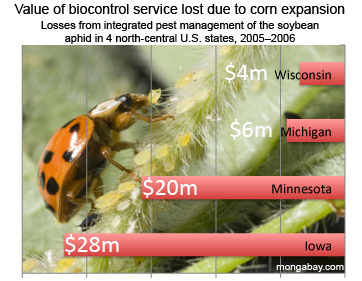Corn expansion is hurting ladybugs
mongabay.com
December 15, 2008
Expansion of corn acreage to meet ethanol targets is reducing the ability of beneficial insects to control pests, a loss valued at $58 million in the four states studied (Michigan, Iowa, Minnesota and Wisconsin), report researchers writing in the journal Proceedings of the National Academy of Sciences.
“Corn is a less favorable habitat for many ladybird beetles (ladybugs) and other beneficial insects that feed on pests such as the soybean aphid,” said Doug Landis, a professor of entomology at Michigan State University and lead author of the study. “As we plant more corn, we reduce the ability of that landscape to supply beneficial predators to control pests in soybeans and other crops. This results in increased pesticide use and yield losses. This research estimates the value of this biological pest control service in soybeans (in the four states) to be about $240 million each year.”
 Estimated annual value of natural biocontrol services against soybean aphid in 4 north-central U.S. states under a crop landscape typical for the period 2005–2006 and under a biofuel-influenced landscape of increased corn. Value of biocontrol services for IPM in millions of dollars based on a 2007–08 projected soybean price of $380 per ton and using actual 2007 corn ha increases per state. Image: Multicolored Asian lady beetle (Harmonia axyridis) consuming a soybean aphid (Aphis glycines) on soybean. Courtesy of Kurt Stepnitz |
“Over-reliance on any one crop is likely to reduce the value of natural control of pest insects by beneficial insects,” added Scott Swinton, professor of agricultural, food and resource economics at Michigan State University and a co-author of the paper. “If we look at farmers who grow only corn and soybeans, increasing corn acreage and reducing soybean acreage will probably mean higher costs for soybean pest control. Beneficial insects help control pests so growers have lower pest control costs.”
The researchers estimate that corn acreage increased by 19 percent in the United States from 2006 to 2007, reducing landscape diversity. More acreage will be needed to meet the ethanol production targets mandated by congress.
“Ultimately, we hope this helps policymakers think about which and how much of any biofuel crop, as well as the location of the crop, makes sense for a particular landscape,” Landis said. “We could choose to create monocultures of a single biofuel crop or have diverse mixtures of many biomass sources including perennial trees and grasses as well as corn. Diverse landscapes often support higher levels of vital ecosystems services such as pest suppression and pollination. Our goal is to provide information so people can make more informed decisions.”
Earlier research has shown that a diverse landscape of native perennial grasses and other flowering plants can yield higher amounts of biofuel per acre that corn or soy, with less need for water, fertilizers, or pesticides.
Douglas Landis, Mary Gardiner, Wopke van der Werf, and Scott Swinton. Increasing corn for biofuel production reduces biocontrol services in agricultural landscapes. PNAS Online Early Edition the week of December 15-19, 2008














